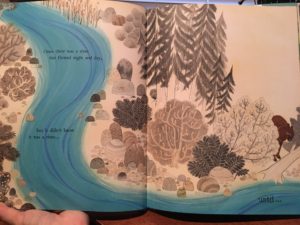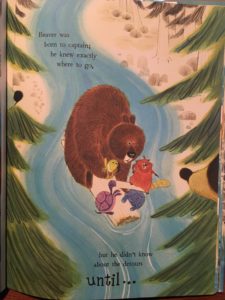Why I Picked It Up: My middle child has a thing for bears, and I guess I do too! I liked the open-endedness of the title and that I couldn’t guess from the cover what the story was going to be about. I thought it might be about an interruption of a camping trip or a picnic or something, but I was wrong!
Why I Finished It: Bear Came Along is written specifically to pull you along, like the river the animals find themselves in, with the clever use of ellipses throughout the story. It was so much fun to read aloud with my kids! The text is simple, but the message is powerful and the illustrations are captivating.
The first character we meet in Bear Came Along is the river, which flows through a forest but didn’t know it was anything special until…Bear came along. Bear’s appearance on the scene begins an epic adventure that none of the animals could have predicted! As Bear floats down the river, he meets all kinds of other animals that join him and have a grand time until…
The animal gang learns a simple, but valuable, lesson about community and the story comes full circle because they would never have learned the lesson if the river hadn’t come along. When it comes to read-alouds from the library, I usually have a once-a-day policy, but Bear Came Along is one that I don’t mind rereading over and over again – I get something new every time I do!
Who I Would Give It To: There is something for every elementary student in this book – whether you read it aloud or use it to practice reading skills. I’d also recommend it for art teachers because of the strategic and very effective way that color enhances the story.
Integration Ideas
Theme – Relationships/Community
- How are people transformed through their relationships with others?
- What is community and what are the individual’s responsibilities to the community as well as the community’s responsibilities to the individual?
- What are the benefits and challenges of a diverse society?
- How does diversity benefit a community?
- What are the benefits and challenges of a diverse society?
The author’s and artist’s notes in the back of the book do a great job of capturing the essence of the theme of Bear Came Along. The river almost becomes a living, breathing character in the book that serves to unite the very different groups of animals. Each animal has a distinct personality and has their own story (we can infer the animal’s backstory from the little snippet we get about each as they are introduced), but they are brought together as they journey on the river. Towards what? They don’t know! But they take it as it comes, and as they work together, they experience the joy of community.
Social Studies and Writing *Fusion*
This theme could easily become a writing assignment – either individual or whole class. The river unifies the group in Bear Came Along. What is it that unifies your classroom? Your students’ families? Your community? Identify that thing and begin to weave in the different characters! Maybe it’s a piece of playground equipment, maybe it’s a certain festival or event – whatever it is, how does it unite a diverse group of people?
One way to introduce this writing assignment would be first to have students reflect on what makes them who they are or describe their culture. I like to have students think of how home and school are different. For example, students explain or write about the music they listen to at home versus the music they listen to with friends or at school. They do the same with food, language, clothing, etc. This activity helps them to see that they are all unique and bring different cultures to their classroom community, but they all come together at school. Next, have students think about the one thing that unifies them at school.
Making Predictions
All the ellipses used to tell the story beg for the reader to practice predictions! Just about every page ends with “until…” or in the middle of a sentence which offers the perfect opportunity to stop and ask your students what they think will happen next. You might have them turn and talk to a partner, you might have them jot their idea on a sticky note, but however you have students make predictions make sure you actually turn the page and have your students see if their predictions were correct! I’m not sure you could get away with NOT turning the page! Good News, Bad News by Jeff Mack is another great story for predictions!
In addition to making predictions, have the older students emulate this text by trying to add ellipses to their own writing. Remember to model with your own writing first. “Right here, I could use ellipses to build suspense and have my reading predict what might happen as a result of ___.”
Illustration Analysis – Color
I don’t think I noticed the subtle use of color until the third or fourth time through, but it really adds to the theme of relationships and how the world changes when we experience it with a community. Even on the front endpaper and flyleaf, the only thing you see in color is the river – everything else is shades of black and brown. Then, on the first page, the river leads you to the first colored figure – the bear! The river is painted with such vibrant blues and in such a way that it really looks like it is in motion, and it carries the story along.

As the story progresses, the reader can notice more and more color until…Ask older students why they think the illustrator chose to use color in this way. What do they notice about where color is placed on the pages? What is significant about the river and why is it in color throughout the story?
Compare the front endpaper and flyleaf to the back endpaper and flyleaf. What do you notice is different? What is the same? Why do you think that?











I love the animals and so did my preschool storytime group at our public library. But shame on me! I was in such a hurry to pick out books this time that I did not notice the subtle change from sepia tones to color. Since I live in coastal Virginia, we have lots of water in our area and children could easily identify with the scenario. What got my attention was the cover with the bear.
That’s awesome that the kids enjoyed the story so much. We never do catch it all the first time, right? There’s always something new to add to the next storytime. We look forward to hearing from you again!